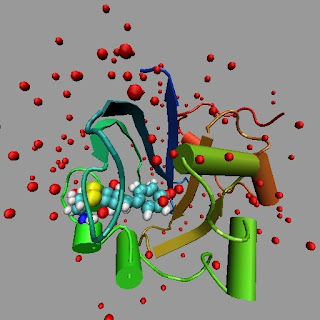Things to do:
- tailor your abstract to your audience (e.g. their backgrounds and interests)
- explain why the topic is interesting
- use words sparingly
- find a balance between being generic and too technical
- include some key scientific ideas you will discuss
- include a brief statement of your main results
- include a few relevant references the really keen may want to look at
- re-write it several times (especially if you are in-experienced)
- superfluous phrases such as "In this talk I will..." and "I will end with some conclusions".
- using acronyms: nLAs, DFT, LDA+DMFT, NMR, ENDOR etc.
- hype
But, it is always easier to tell people what to do rather than actually do it yourself! So I offer up for critique my latest abstract: for the UQ Physics Colloquium next friday.
Quantifying the limited role of quantum dynamics in biomolecular function
Quantum effects such as coherence, interference, tunnelling, and entanglement are well established at the level of atoms and small molecules in a vacuum. However, could quantum "weirdness" occur in large biomolecules which are in thermal equilibrium with water at room temperature? I will show how it is possible to give a quantitative description of quantum decoherence for the excited states of optically active biomolecules in a native environment [1].
A key to a quantum description of biomolecules are the multiple time, energy, and length
scales associated with the dielectric relaxation of proteins and water. In most cases appears that quantum coherence requires time scales less than 1 picosecond and distances less than 10 nm.
This work provides a framework to critical evaluate the claims of some physicists (and New Age pop psychology gurus) that quantum effects are important in biology. Such speculations have increased in the past few years stimulated by some experimental results concerning photosynthetic systems.
I contend that most claims of "quantum biology" are based on wishful thinking and involve
(i) debatable data analysis with an excessive reliance on curve fitting,
(ii) a misunderstanding of what biological evolution implies about efficiency, and/or
(iii) speculations which go far beyond what the experimental data may imply.
Nevertheless, there is a lot of interesting physics involved in understanding the role of quantum decoherence in biomolecular function at sub-nanosecond timescales.
One key challenge is for specific class of processes defining an effective Hamiltonian. This must find a balance between the level of detail normally used in physics, chemistry, and biology. I will briefly illustrate this with recent work on Green Fluorescent Proteins [2]. A second challenge is solving the quantum dynamics in realistic parameter regimes where there is no simple separation of time scales.
[1] J. Gilmore and R.H. McKenzie, J. Phys. Chem. A 112, 2162 (2008).
[2] S. Olsen and R.H. McKenzie, J. Chem. Phys. 130, 184302 (2009).





I think the second reference may be mixed up -- the volume, page and year correspond to your New Journal of Physics article on quantum tunneling in enzymes.
ReplyDeleteWow! You are on the ball! Thanks. I will correct it.
ReplyDeleteIf you want the abstract to be more like a press release—that is, to grab readers quickly and effectively—then you should answer the rhetorical question in the second sentence more promptly.
ReplyDeleteSo I suggest you insert a new, third sentence that says something like:
Yes, but on scales of time and length that make quantum effects largely irrelevant to biology
By the way, the talk looks fascinating. Do you plan to give it in the US?
Charles